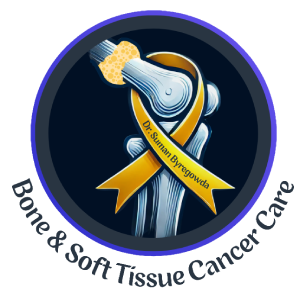

You need to consult an orthopedic oncologist for Ewing’s sarcoma because they specialize in bone cancers. They have the knowledge and experience to diagnose, treat, and manage bone tumors like Ewing's sarcoma. They know how to handle complex surgeries and treatments to ensure the best care for the patient.
Ewing’s sarcoma is a rare type of bone cancer that mainly affects children, teenagers, and young adults. It starts in the bone or soft tissue, usually in the arms, legs, or pelvis. It is an aggressive cancer that can spread to other parts of the body if not treated early.
Ewing’s sarcoma most commonly affects children and teenagers, typically between the ages of 10 and 20 years old. It is one of the most common bone cancers in young people.
Ewing’s sarcoma commonly affects the following bones:
The exact cause of Ewing’s sarcoma is not fully understood, but it is believed to be related to genetic changes or mutations in the DNA of bone or soft tissue cells. In most cases, there is no clear cause and they don’t run in family so siblings and immediate family are not at risk.
Ewing’s sarcoma is diagnosed through:
Yes, a needle biopsy is usually needed to confirm the diagnosis of Ewing’s sarcoma. A small sample of tissue from the tumor is taken to check for cancer cells and determine the type of cancer. This is a key step in diagnosing the disease.
The main treatments for Ewing’s sarcoma include:
Yes, in many cases, limb-salvage surgery can be done to remove the tumor while saving the limb. This surgery removes the tumor and may use prosthetics or bone grafts to preserve the function of the arm or leg. In this era, we can save limb in more than 90-95% of the patients
Yes, Ewing’s sarcoma can be cured with early diagnosis and proper treatment, especially if it is localized (not spread to other areas). The chances of a cure are highest when the cancer has not spread and when treatment involves a combination of surgery, chemotherapy, and sometimes radiation. Cure rate of localised Ewing’s sarcoma is about 60-80 percent.
Ewing’s sarcoma can sometimes come back after treatment, which is called a recurrence. This usually happens within the first few years after treatment. Regular follow-up visits and scans are important to monitor for any signs of recurrence. High chance of recurrence seen in large volume disease, if cancer had already spread to other parts of the body and not responding well for chemotherapy.
Yes, many patients with Ewing’s sarcoma can go on to live a normal life after treatment, especially if the cancer is caught early and treated effectively. The person may need some time for recovery, rehabilitation, and physical therapy, but many people return to normal activities like school, work, and sports.
No, Ewing’s sarcoma is not contagious, so it will not spread to family members or caregivers. It is a type of cancer that starts in the individual’s own cells and is not passed from person to person.
Osteosarcoma is a type of bone cancer that requires surgery as the main treatment. However, chemotherapy (using medicine to kill cancer cells) is given before and after surgery to shrink the tumor and kill any remaining cancer cells. If tumour is non-operable, radiotherapy can be an effective treatment.
Radiotherapy (or radiation therapy) is used in Ewing’s sarcoma when surgery isn’t possible or to shrink tumors before surgery. It can also be used after surgery to kill any remaining cancer cells and reduce the risk of the cancer coming back. Radiation helps target and destroy cancer cells, particularly in areas where surgery might be difficult.